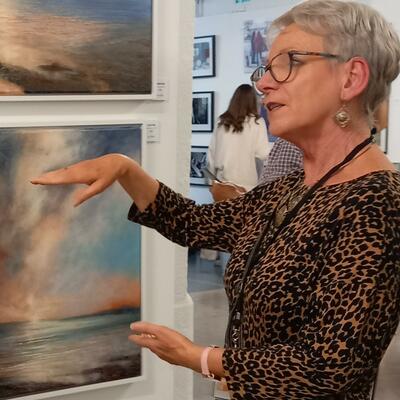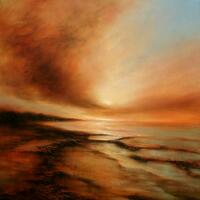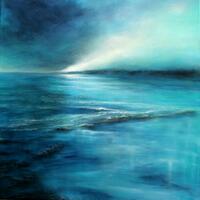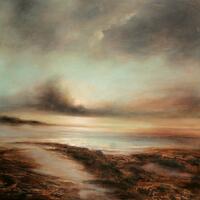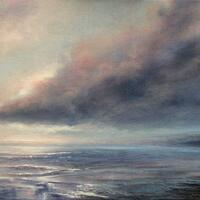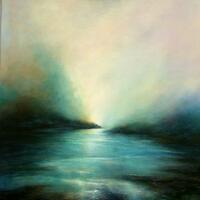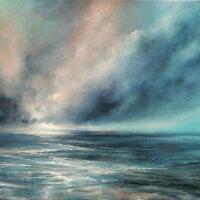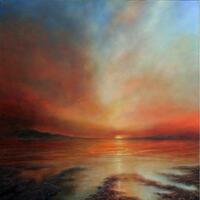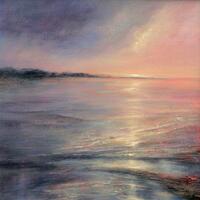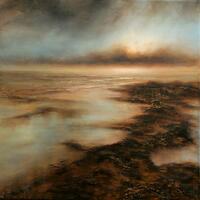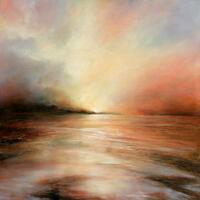Sussex Art Fair, stand 58, Goodwood Racecourse, 10th-12th May
Bath Art Fair, stand 37, Bath Pavillion, 14th-15th September
Art Surrey, Epsom Racecourse, stand 77, 4th-6th October
I live in the gentle Hertfordshire countryside but I love wild places where sky, sea and land meet. My exercise of choice is scuba diving and I elect to fall asleep at night to the sound of waves rolling in. Naturally, I paint seascapes.
The recollection or idea of a place is more evocative and fascinating to me than its physical appearance. Working intuitively from memory and imagination, using layers of texture and colour, I strive for luminous effects that are informed but not determined by the observation of nature. I am interested in spiritual and emotional qualities, not imitative realism.
The natural features that are my subject express more than materiality. The sky conveys the transcendent, that which is outside of and greater than ourselves. The sea indicates the ungovernable forces of nature and the land is both our home and the material of which we are made. Blurring the transitions between these elements, I aim to create a degree of uncertainty around their boundaries, to provoke curiosity about these ambiguous places and invite pause and reflection on these themes.
Process:
In order to keep the painting surface fresh and lively, my preferred medium for the first layers of a picture is acrylic, frequently followed by further transparent layers in oils to achieve the desired luminosity. The fast drying time of acrylic encourages me to work quickly in the early stages, resolving marks, opacity and values instinctively, and avoid overworking.
I have four questions I ask about each painting before I am satisfied that it needs no further work.
1. Is it beautiful?
Beauty matters to me, not for any superficial aesthetic whim but because I believe humans are hard-wired to respond positively when confronted by it – we find it uplifting, beneficial to our mental and emotional wellbeing. Of course this goal can be elusive! No two humans share an identical vision of what constitutes beauty but feeling a deeply satisfying sensation when witnessing beauty in nature is a pretty universal experience.
2. Is it luminous?
Capturing light has always fascinated artists. I vividly recall entering a Rembrandt gallery in the Rijksmuseum in Amsterdam with my young teenage daughter who exclaimed “that painting (The Night Watch) has light coming out of it!” This is my goal!
3. Does it have a sense of space?
Although my pictures do not depict specific geographical locations, I do want to create a believable imaginary space that draws the viewer in, to the point where you might get your feet wet. In this space, there is the possibility of evoking the memories and emotions particular to each individual.
4. Is it a little mysterious?
Transient, impermanent, indefinite qualities in a painting invite the viewer to participate in the interpretive process. In common with poetry, I want to create the possibility of multiple interpretations. This is ultimately much more satisfying than regarding a ‘complete’ visual statement, however brilliantly and accurately it has been realised.
Education
My childhood ambition was to go to art school, although I wasn’t really sure what that entailed. After finishing A levels I completed a Foundation Course in Art and Design in North London, followed by a BA(Hons) in Graphic Design in Bristol.
I practiced as a designer for six years, first in Oxford and later in London. I subsequently trained as an art educator at the University of Cambridge, Homerton College. Throughout my eighteen years teaching, I continued to develop my personal studio practice in two and three dimensional media. Painting has consistently dominated my practice and is now the exclusive focus of my working life.
